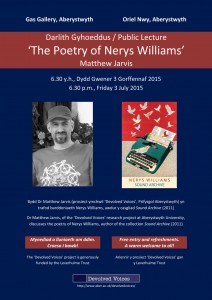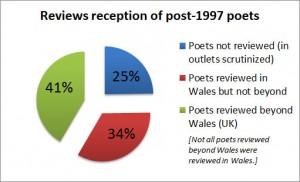I’ve been interested by statistics to do with national identities in post-devolution Wales for quite a while, and the recent Welsh Devolution in Perspective conference at the British Academy got me thinking about the issue again.
Cardiff University’s Professor Richard Wyn Jones was one of the speakers at the event, and references he made to the 2011 Census made me realise that there were things in the Census data that might well be important for our understanding of national identity in the post-devolution period. And this is an issue that is clearly important for Devolved Voices: the project crucially challenges us to address potential relationships between post-1997 Anglophone Welsh literature and the socio-cultural milieu out of which it emerges.
What RWJ said, then, was that the results of the 2011 Census question about national identity indicate a weak sense of British identification and a strong sense of Welsh identification in the Welsh population. (These are the results for Question 15 in the ‘Individual questions’ section of the 2011 Census questionnaire: ‘How would you describe your national identity?’) Strange, I thought: if that’s the case, don’t the results about Britishness conflict with existing information about national identity in Wales?
As RWJ pointed out to me in a subsequent conversation, the Census hasn’t asked this particular national identity question before. (The row about the lack of a Welsh tick-box in the 2001 Census was, of course, to do with the question in that Census about ethnic identity.[1]) So, in the strictest sense, the 2011 Census results about national identities exist without comparative context. Or to put it slightly differently, the information drawn together by the Census isn’t directly comparable with previous statistical considerations of the same broad issue, as earlier surveys have (for example) been collected along different lines and under different conditions from the Census itself.
Admitting this caveat, what Richard Wyn Jones had said at the conference still surprised me. Turning to Martin Johnes’s recent volume Wales Since 1939 (Manchester University Press, 2012), p. 431 very helpfully offers a table of Moreno scale surveys of national identity in Wales from 1992 to 2007 (table 14.3).[2] Just a little data-crunching from the figures in this table suggests that, in recent years, a significant percentage of the population of Wales has had some level of identification with British identity – either alone or in some sort of combination with Welsh identity.
To get the amounts of people identifying in some way with Britishness, you need to exclude respondents identifying with the ‘Welsh not British’ label, as well as anyone who does not identify themselves at all with the various Welsh/British options offered by the Moreno scale. If you do this, Britishness plays a part in the various surveys as follows: 71% of respondents in 1992 considered themselves in some way to be British; 80% in 1997; 76% in 1999; 73% in 2001; 73% in 2003; and 72% in 2007.[3] Even if you exclude the weaker British identification suggested by the ‘More Welsh than British’ category of respondents, the figures come out as follows: 51% in 1992; 51% in 1997; 57% in 1999; 50% in 2001; 46% in 2003; and 51% in 2007. Some sense of Britishness, in other words, has apparently been a substantial player in the national self-identification of the Welsh population in recent years.
Then we have the 2011 Census. The national identity question allowed respondents to choose multiple identities, although not (and by contrast with the Moreno scale) to indicate their comparative importance. The upshot – according to the separately downloadable chart associated with Figure 4 of the ONS document Ethnicity and National Identity in England and Wales 2011 – was a level of British identification across the Welsh population which was around half as large as the latter set of figures cited above: 26.3%.
But what if we consider the data Johnes cites in terms of what it tells us about Welsh identification? Well, in that case, we see the following: 85% of respondents in 1992 identified in some way with Welshness; 78% in 1997; 79% in 1999; 86% in 2001; 85% in 2003; and 84% in 2007.[4] Again, if you remove the weaker element of Welsh identification (the ‘More British than Welsh’ category), you get this: 78% in 1992; 68% in 1997; 72% in 1999; 75% in 2001; 77% in 2003; and 74% in 2007. The Census tells us that 65.9% of respondents self-identified with Welshness (either alone or in combination).[5] In other words, there is far less of a difference between these figures than there is between the corresponding figures for Britishness. Or to put it differently: identification with Welshness seemingly holds up between the two different survey approaches, whilst identification with Britishness does not.
Of course, as I said above, detailed or direct comparisons are difficult to draw between the Moreno scale data that Johnes’s book gives us and the rather different form of the data obtained by the Census. Nonetheless, the detailed breakdown of 2011 Census data provided in the ONS data sheet 2011 Census: National identity (detailed), local authorities in England and Wales (document QS214EW) does give some pause for thought.
From this more detailed Census data, then, we discover that British-only identifiers in the Welsh population come in at 16.9% – interestingly not much below the 19.2% for England. Moreover, that 16.9% also broadly resonates with at least some of the figures that Johnes cites for the proportion of ‘British not Welsh’ identifiers since 1992: 14% in 1992; 15% in 1997; 14% in 1999; 11% in 2001; 9% in 2003; and 10% in 2007.
Turning to Welsh-only identifiers in the Census, we find that this cohort comes in at an average of 57.5% across the country as a whole – with the highest percentage figure being found in Rhondda Cynon Taf (73.3%). By contrast, the ‘Welsh not British’ cohorts in Johnes’s table never reach past 28% (in 1992). (In the years of the devolution ‘yes’ vote in 1997 and the establishment of the WAG in 1999, the figures for ‘Welsh not British’ identification were 13% and 17% respectively; the most recent figure cited by Johnes, 2007, was 22%.) Even taking into account that the Census data set is structurally different from the sets cited in Johnes’s book, the broad suggestion of difference here is striking.
It is, however, in the combination of British and Welsh identity that such a ‘broad suggestion of difference’ is perhaps most startling. Even if we only consider the ‘Equally British and Welsh’ cohort of the data sets given in Johnes’s book (i.e. if we exclude the ‘More Welsh than British’ and ‘More British than Welsh’ categories from a combined British and Welsh identification), the percentage of such identifiers is as follows: 30% in 1992; 26% in 1997; 36% in 1999; 28% in 2001; 29% in 2003; and 31% in 2007. Indeed, in all the sample years except 1997, ‘Equally British and Welsh’ was the plurality category of national self-identity. In the Census, however, respondents who identified themselves as both British and Welsh (with no other identifiers chosen alongside those two) came in at just 7.1% across the whole of Wales – a figure that is, it should be noted, less than English-only identifiers, whom the Census indicates as accounting for 11.2% of the population of Wales.
As merely an interested observer rather than a trained political scientist, I’m cautious about trying to draw anything like precise conclusions from two clearly different sorts of data. Indeed, I would be very pleased to hear from any experts about what implications the differences in data collection and question construction might have for the sets of data themselves – and for how they might be read against one another.
However, I find it hard get away from the fact that there are apparently some very substantial differences between the broad suggestions about national identity in the surveys cited in Johnes’s book – surveys, of course, going back a number of years – and the results of the 2011 Census. The large size of the cohort in the Census that self-identifies as Welsh-only is one striking thing; the small percentage of those who identify as both British and Welsh is a second; and the modest level of British self-identification as a whole is a third. Then there is what I suggested above: that identification with Welshness seemingly holds up across the Moreno scale surveys and the Census; levels of identification with Britishness, however, do not.
It would, I think, be somewhat naïve to draw those final observations to the defence of a position that sought to argue, in a very straightforward manner, that Wales-associated literary production is now taking place in the context of some sort of newly dominant Welsh identification on the part of the population of Wales. However, I’m tempted to speculate that there may be something here about the apparent resilience of Welsh identity – in other words, that self-association with Welsh identity in the Welsh population is something that does not seemingly disintegrate in the change from one sort of survey to another. Might any political scientists care to comment? Because if this is the case – this notion of the resilience of Welsh identification – then it’s an issue that certainly demands some thought in the context of a project that requires attention to the socio-political contexts out of which poetry emerges.
Notes
1. The 2001 ‘Wales Household Form’ is available to download from http://www.ons.gov.uk/ons/guide-method/census/census-2001/about-census-2001/census-2001-forms/index.html. Question 8 in the sections for each individual ‘Person’ in the household is about ethnic identity; there is no question about national identity. For a brief explanation of the rationale behind the new question on national identity in the 2011 Census, see the ONS document Ethnicity and National Identity in England and Wales 2011, p. 10.
2. The Moreno scale asks respondents to place themselves in one of the following categories: ‘Welsh not British’, ‘More Welsh than British’, ‘Equally Welsh and British’, ‘More British than Welsh’, ‘British not Welsh’, ‘None of these’.
3. These figures draw together the following cohorts: ‘More Welsh than British’, ‘Equally Welsh and British’, ‘More British than Welsh’, and ‘British not Welsh’.
4. These figures draw together the following cohorts: ‘Welsh not British’, ‘More Welsh than British’, ‘Equally Welsh and British’, and ‘More British than Welsh’.
5. As in the previous paragraph, this figure is drawn from the separately downloadable chart associated with Figure 4 of the ONS document Ethnicity and National Identity in England and Wales 2011.


